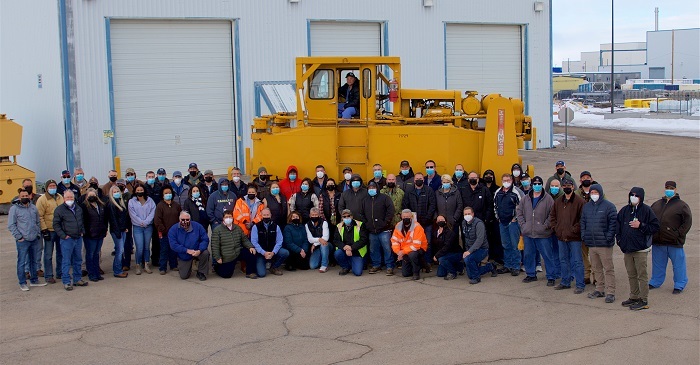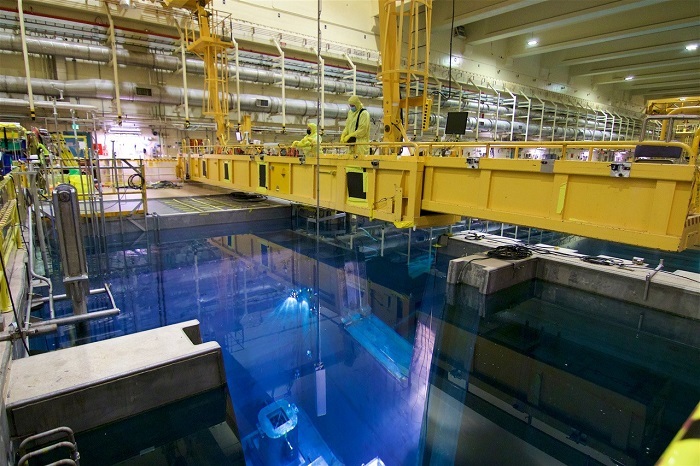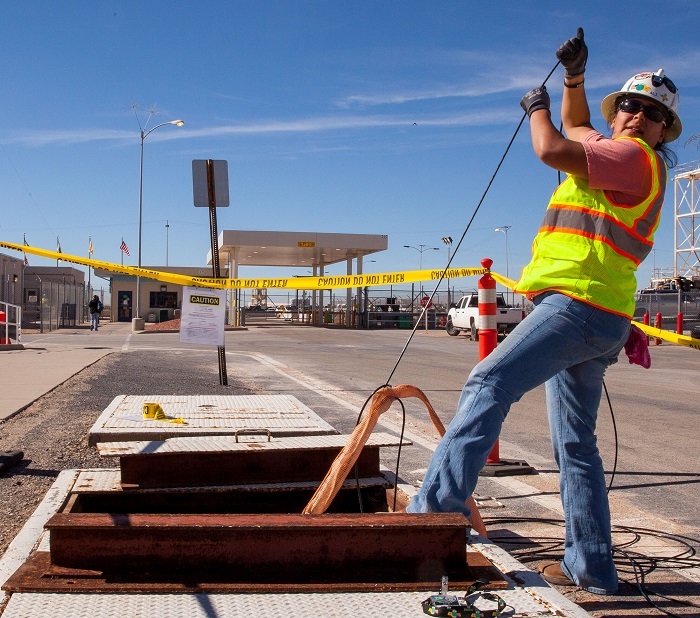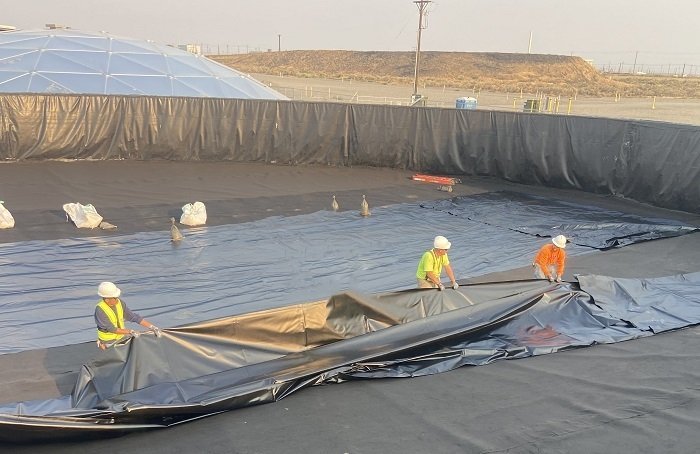 The Idaho Environmental Coalition and DOE Idaho Spent Nuclear Fuel management team are shown outside the Chemical Processing Plant-666 following the recent completion of Advanced Test Reactor fuel retrieval.
IDAHO FALLS, Idaho – EM crews at the DOE Idaho National Laboratory (INL) Site recently retrieved the last of the Advanced Test Reactor’s (ATR) spent nuclear fuel elements from a water-filled storage basin and transferred them to a nearby dry-storage facility in support of a 1995 agreement with the State of Idaho.
“I’m extremely proud of our team for accomplishing this task safely and compliantly,” said Jay Schnelle, spent nuclear fuel shift operations manager for EM INL Site cleanup contractor Idaho Environmental Coalition (IEC).
The accomplishment means there’s just one fuel type remaining in the DOE complex’s largest spent nuclear fuel storage basin. Remaining Experimental Breeder Reactor-II (EBR-II) spent nuclear fuel elements are set to be transferred to dry storage or processed at another INL Site facility by December 2023.
IEC Nuclear Facility Manager Pat Spaulding said she was impressed how staff members from a variety of operational disciplines came together for a common goal.
“Reaching this milestone and witnessing the teamwork of such talented people is a testament of just what can be accomplished,” she said.
 Spent nuclear fuel handlers move the last Advanced Test Reactor fuel to an awaiting cask in the Chemical Processing Plant-666 basin.
The ATR, a 250-megawatt test reactor operated by DOE Office of Nuclear Energy contractor Battelle Energy Alliance, has been conducting experiments for customers since the late 1960s. It has also provided medical isotopes for the treatment of cancer and other diseases. In the past, the reactor’s spent nuclear fuel was transferred to the Chemical Processing Plant (CPP)-666 storage basin for cooling and shielding. Spent nuclear fuel from the reactor now cools in its canal and is transferred directly to the CPP-603 dry-storage facility.
The basin at CPP-666 is nearly empty. There are 1,193 bottles of EBR-II spent nuclear fuel remaining in the basin. The basin will eventually be drained of water and closed.
The EBR-II reactor operated at the former Argonne National Laboratory-West, now the Materials and Fuels Complex, from 1964 until 1994. The reactor generated power for the INL and provided reactor research benefits. Spent nuclear fuel from EBR-II was transferred to wet storage at CPP-666 from 1986 to 1999.
“This project has had its challenges, but none so great they weren’t overcome by a focused team ready and capable of taking care of business. I’m excited to witness the fruits of their efforts now that the last Advanced Test Reactor spent nuclear fuel elements are transferred,” said Roger Friesz, the ATR spent nuclear fuel wet-to-dry transfers project manager.
Under the 1995 Idaho Settlement Agreement, the next remaining milestone after the December 2023 spent nuclear fuel wet-to-dry deadline is to have the spent nuclear fuel “road ready” to leave the state for interim storage or sent to a national geologic repository. That scope must be completed by 2035.
-Contributor: Erik Simpson
 Conduct-of-operations coaches and mentors, from left, Rick Bodette, Lawrence Fitts and Merri Johnson work with shift crews at the Waste Treatment and Immobilization Plant as the team nears cold- and then hot commissioning. This photo was taken prior to new COVID-19 protection guidelines relating to use of cloth masks.
RICHLAND, Wash. – As any sports fan can attest, achieving greatness takes more than just a team full of star players. Experienced coaches need to design the plays and guide them to success.
The team at the Hanford Site’s Waste Treatment and Immobilization Plant (WTP) follows that model in its approach to operations with the recent addition of conduct-of-operations coaches.
The coaches, who have experience in nuclear or environmental cleanup operations, observe work performed, provide constructive feedback and reinforce positive operational behaviors. Their mentoring, training and coaching help implement a disciplined and structured operations approach to support commissioning and future operations while promoting worker, public and environmental protection.
“These operations coaches help shape our staff’s behaviors and conduct as we move into melter heatup, cold and hot commissioning and future Direct-Feed Low-Activity Waste (DFLAW) Program operations,” said Eugene Nemeth, deputy nuclear facility manager for Waste Treatment Completion Company, a subcontractor to project lead Bechtel National, Inc. “Their experience and mentorship provide our team with valuable insights and learning.”
The WTP employs three coaches: one from Hanford contractor Washington River Protection Solutions and the others from Bechtel’s team at the Pueblo Chemical Agent-Destruction Pilot Plant in Colorado. There are plans to hire a fourth coach in the near future, with each coach supporting the four rotating operations shifts.
The addition of the coaches is part of a larger strategy at the WTP to enhance the operational mindset and culture, which includes the creation of a conduct-of-operations council. The council is the governing body for ensuring continuous improvement of facility operations using the WTP conduct-of-operations program. The objectives of the council are to provide oversight and direction for plant-wide conduct of operations, including implementation and monitoring, and recommendations regarding program effectiveness, lessons learned and consistency.
The team is closing in on heatup of the first melter that will be used during the DFLAW Program operations to convert radiological and chemical waste from the Hanford tank farms into a form safe for disposal.
The plant facilities can be viewed using the self-guided Hanford Virtual Tour.
-Contributor: Tyler Oates
 One of the 20 aircraft in the Savannah River National Laboratory Unmanned Aircraft System fleet.
AIKEN, S.C. – A team that operates camera-mounted drones at the Savannah River National Laboratory (SRNL) has been recognized with the 2021 Unmanned Aircraft System (UAS) Unit Award by DOE’s Office of Aviation Management.
This is the second consecutive year that the SRNL team has won the award, which is based on criteria including management, operations, maintenance, training, safety, and best practices. Nominations of UAS teams were reviewed and judged by an external, independent panel consisting of subject-matter experts from the Federal Aviation Administration (FAA), the Department of Defense and civil aviation.
“The SRNL UAS Team continues to exceed expectations,” SRNL Associate Lab Director for Global Security Tammy Taylor said. “In the coming year we intend to further grow and develop the UAS program, our relationships and collaborative missions.”
Among the uses of the camera-mounted drones is to ensure the structural integrity of protective covers over EM’s remediated waste sites at the Savannah River Site.
The team consists of a program manager, operations manager, aviation safety officer, six FAA-certified pilots and remote pilot. Another individual serves as ground-control support and as a visual observer. The SRNL UAS Program has 20 UAS aircraft in its fleet and the team works closely with the DOE-Savannah River Site aviation manager and safety officer to plan and conduct onsite missions under an approved flight readiness review board.
In 2021, SRNL logged over 100 flight hours and more than 350 flights. Missions included exercises with the U.S. Marines and Air Force, infrastructure inspections, aerial photography and videography, emergency response exercise support, training and currency, research and development activities, and other U.S. government support.
-Contributor: Scott Shaw
 Ali Martinez, an employee with Stellar Inc., a subcontractor to Waste Isolation Pilot Plant (WIPP) management and operations contractor Nuclear Waste Partnership, pulls a length of fiber-optic cable as part of the installation process of more than 137,000 feet of cable at the WIPP site.
Workers will pull more than 137,000 feet of new fiber-optic cable through conduit to connect WIPP buildings, including the Central Monitoring Room, to computer servers.
The fiber-optic network, currently about 90% complete, promises to make the WIPP system faster, more reliable and more secure. All that remains is to connect the cable inside site buildings.
The new cable will boost performance of the site intranet, or internal network, between computers and servers because of the upgrade to single-mode, higher bandwidth fiber and faster switches.
WIPP has been operating on 10/100 Ethernet switches – that means a data transfer rate of 10 megabits per second to 100 megabits per second. The new switches are the latest standard, known as gigabit Ethernet, 1,000 megabits, or 1 gigabit, per second.
First developed in the 1970s, optical fiber is a flexible, transparent fiber made by drawing glass or plastic to a diameter slightly thinner than a human hair. Fiber-optic technology transmits information such as phone, TV and internet services as pulses of light through the strands. An outer layer, known as “cladding,” wraps around the central strand and causes light to repeatedly bounce off the walls of the cable rather than leak out at the edges, enabling the signal to go farther. Fiber optics is preferred because of its higher data transfer rates and transmission over longer distances.
Twenty times faster than cable, fiber optics technology is immune to electromagnetic interferences, has high electrical resistance so it can be used near high-voltage equipment, weighs less than cable, and is difficult to tap, which is important in a high-security environment.
-Contributor: Roy Neese
 Workers with EM contractor Central Plateau Cleanup Company install heavy-duty liners inside two 400,000-gallon leachate tanks at the Integrated Disposal Facility at the Hanford Site.
RICHLAND, Wash. – EM recently released contract award fee determination scorecards for four prime contractors that support the cleanup program at the Hanford Site based on their performance during varying evaluation periods in the fiscal year ending Sept. 30, 2021.
EM releases information relating to contractor fee payments — earned by completing the work called for in the contracts — to further transparency in its cleanup program.
Washington River Protection Solutions
EM Office of River Protection (ORP) tank operations contractor Washington River Protection Solutions (WRPS) received approximately $41.7 million, or about 94 percent, of the available fee for work performed in fiscal 2021.
According to its scorecard, WRPS’s performance was “very good” in the management of the tank farms and business operations; conduct of operations, engineering, maintenance and nuclear safety; and environment, safety, health and quality.
Of note in these performance areas, WRPS maintained worker safety and responsiveness to the COVID-19 pandemic while accomplishing key goals for readiness of the Direct-Feed Low-Activity Waste (DFLAW) Program and meeting regulatory commitments. The contractor also continued to implement a robust safety culture, receiving Voluntary Protection Program Participants Association awards for outreach and innovation.
Opportunities for improvement in WRPS’s performance include the quality, completeness, and prompt submittal of notice of construction permit applications to DOE and regulators as well as quality assurance oversight of procurement efforts.
View the WRPS scorecard here.
Hanford Laboratory Management and Integration
ORP awarded 222-S Laboratory contractor Hanford Laboratory Management and Integration (HLMI) approximately $977,000, or about 75%, of the available fee for work performed from May 26, 2021 to Sept. 30, 2021.
HLMI received “very good” ratings for data quality and assurance systems; environmental compliance and stewardship; worker safety, health, and safety culture; and facility and instrument availability. The contractor received “good” ratings for contract cost control and site mission cost impacts; business and interface management; and research and technology development.
Their performance in those areas includes accomplishments such as maintaining worker safety and health through collaboration with other Hanford contractors to develop and maintain COVID-19 controls; correcting legacy issues in performance testing for failed metal analyses resulting in reestablishment of the laboratory’s accreditation for these analytes; and achieving a 60% improvement in turnaround timeframes for industrial hygiene sample analysis and reporting in the first three months of the contract.
Areas for improvement include the quality of contractor invoices, overtime requests and contract proposals submitted to DOE; timeliness in communicating potential issues and concerns to DOE at the appropriate levels of management; and timely submittal of contract deliverables by their contractual due dates.
View the HLMI scorecard here.
Central Plateau Cleanup Company
EM’s Richland Operations Office (RL) awarded Central Plateau cleanup contractor Central Plateau Cleanup Company (CPCCo) approximately $20.8 million, or about 78.5%, of the available fee for work performed from Jan. 25, 2021 through Sept. 30, 2021.
According to the scorecard, CPCCo’s achievements included treating more than 1.66 billion gallons of contaminated groundwater while continuing effective COVID-19 pandemic response and integration with other Hanford contractors. The contractor also completed stabilization of aging structures; Plutonium Reclamation Facility demolition and debris loadout; sustained Integrated Disposal Facility infrastructure modifications; and environmental permitting in support of the DFLAW Program mission.
Opportunities for improvement in CPCCo’s performance include business and administrative functions.
View the CPCCo scorecard here.
Hanford Mission Integration Solutions
RL awarded mission-support contractor Hanford Mission Integration Solutions (HMIS) approximately $13.7 million, or about 86.8%, of the available fee for work performed in the initial eight months of HMIS’s contract with the Department, which started Jan. 25, 2021.
According to the scorecard, HMIS exceeded a number of award-fee criteria and met overall cost, schedule and technical performance requirements of the contract. Accomplishments include protecting the health and safety of its workforce by taking a lead in coordinating site-wide COVID-19 response activities, and providing key services and infrastructure to the other Hanford contractors to enable continued progress in Hanford missions.
Opportunities for improvement in HMIS’s performance include improving project management, maintenance of fire systems and financial management controls.
View the HMIS scorecard here.
|